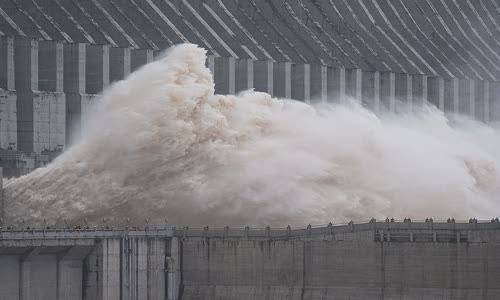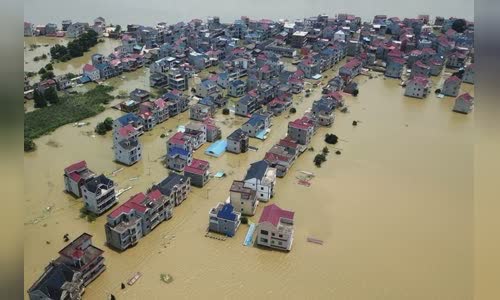The historic flood in 1998 forced China to rethink its natural disaster response strategy, relying more heavily on afforestation and riverbank restoration.
The rainy season in southern China this year lasts almost twice as long as normal.

The Three Gorges Dam in Hubei Province, China, flooded on July 19 Photo: Xinhua.
"The normal rainy season lasts about 24 days, but this year is up to 43 days," said Xiquan Dong, an expert on extreme weather at the University of Arizona, USA, of the recent weather development in China.
However, the flood damage this year is not as catastrophic as the historic floods in 1998. Some environmental experts believe this result is due to disaster mitigation strategies based on
"This year's rainfall is much higher than in 1998, but the floods are less severe and also cause less damage," said Liu Junguo, professor of the School of Environmental Science and Engineering at the University of Science and Technology.
Floods this year left 158 people dead and missing, and more than 400,000 homes were destroyed, according to China's Ministry of Emergency Response.
The Chinese government attributed the 1998 floods to extraordinary heavy rains, widespread deforestation and high population density along the Yangtze River and its tributaries.
According to Professor Liu, the 1998 disaster caused the Chinese government to rethink its entire strategy for flood planning and management.
"This is certainly a very important turning point in the Chinese government's thinking about the relationship between man and nature," Liu said.
For centuries, China's flood control strategy has mainly relied on dykes built on the banks of the river, to separate the overflowing river water from the living and farming areas of the people on the other side of the dike.
However, the dyke system that sprouted along all the rivers caused the flood water to rise higher, putting greater pressure on the increasingly overloaded and degraded dykes.
In order to overcome the damage caused by the overloaded dyke system, China has launched a number of major ecological restoration projects, planting billions of trees to prevent water in the mountains from flowing into the river and retain more water.

Shanghai City, Jiangxi Province, China, flooded in July Photo: Reuters.
"The Chinese government has initiated a lot of forest restoration programs," said Liu.
Liu said his studies show that depending on the context and topography, afforestation can reduce flooding by up to 30%.
In addition, the Chinese government is actively implementing "sponge city" projects with the goal of increasing green spaces and water-absorbing sidewalks to absorb more rainwater in urban spaces.
According to Jeff Opperman, freshwater scientist at the World Wildlife Fund, China's new strategy also focuses on restoring the status quo of alluvial areas along the Yangtze River.
"The mudflats are a natural type of terrain. Rivers tend to rise and then overflow into the mudflats seasonally relatively regularly," Opperman said, adding that relocation of people away from the areas
Ideally, he said, the government should have policies that prevent people from living with high densities in mudflats in the first place.
After the floods in 1998, the Chinese government persuaded 2.4 million people to leave the land along the Yangtze River, to restore nearly 2,600 km2 of alluvial land.
Liu says that these nature-based interventions have been effective.
However, according to David Shankman, a China flood expert at the University of Alabama, USA, convincing tens of millions of people to move out of the floodplain of the Changjiang River is almost impossible.
"It is the center of China's granary," he said.

People watched the flood discharge of the Threemen Dam in Henan Province, China, on June 30 Photo: AP
Many families have lived here for generations and they do not want to give up farming.
China has invested billions of dollars to build dams on the Yangtze River and its tributaries.
Critics are now skeptical of the dam's effectiveness and some have expressed concern that the dam could be damaged when water pressure increases upstream.
Climate change will make average rainfall above average along the Truong Giang River, says expert Xiquan Dong from the University of Arizona.
"With climate change, the ocean temperature will increase, causing more water vapor to form in southern China," Dong said.
Numerous studies carried out over the past decade have confirmed Dong's findings.
China's large-scale flood management projects can help the world know what works and what doesn't work, says Cecilia Tortajada, water policy expert at the University of Singapore.
"In terms of flood water management, they've learned a lot," she said.
Countries should be prepared for a world in which more intense floods will occur.
"The floods will not go away," she stressed.



 Candy Mason
Candy Mason







